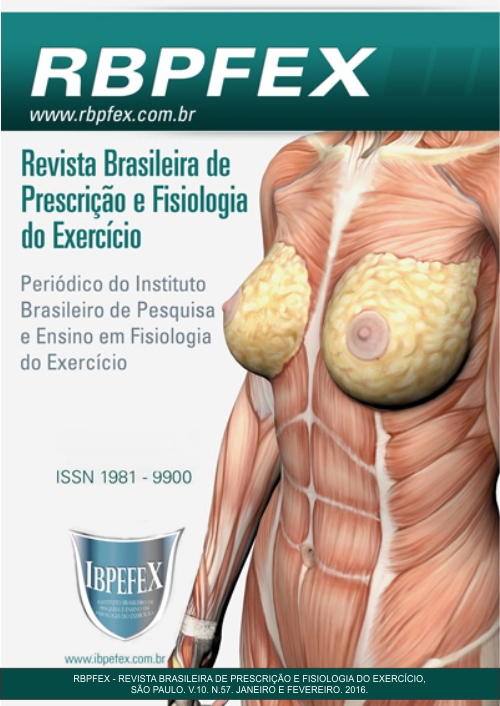Comparative study of cardiorespiratory capacity of freshmen in the military in five regions of Brasi
Abstract
Introduction: Cardiorespiratory fitness is the body's ability to resist the state of fatigue when subjected to physical exertion, with emphasis in the military due to the demand of activities that make up the functional performance in military institutions. Objective: The objective of this research was to conduct a comparative study of cardiorespiratory freshmen in the military in five regions of Brazil. Methods: The sample consisted of 764 young people aged between 18 and 21 years old, apparently healthy, submitted preliminary to a health inspection. The evaluation of cardiorespiratory fitness was performed using the Cooper test enabling the determination of VO2max. Results: The young evaluated in the North, South and Southeast had more significant results when compared with the evaluated in the Northeast and Central-West that had less significant results with respect to cardiorespiratory fitness levels. In the Southeast find the best results (average of 3192 meters traveled, indicating VO2max of 59.7 ml.kg.min-1), while in the Northeast the worst results were found (average of 2265 meters traveled, indicating VO2 max.of 39.1 ml. kg.min-1). Conclusion: Cardiorespiratory fitness levels obtained in the five regions were satisfactory, however, no statistical differences were observed, reinforcing the importance of developing public policies, especially in the poorest areas, seeking to facilitate the practice of healthy habits by society, through practice regular physical exercise. Military Organizations in the use of appropriate methodologies to physical training is essential so that the desirable standards are achieved
References
-Almeida, J. A.; Campbell, C. S. G.; Pardoro, E.; Sotero, R. C.; Magalhães, G.; Simões, H. G. Validade de Equações de Predição em Estimar o VO2max.de Brasileiros Jovens a Partir do Desempenho em Corrida de 1600m. Revista Brasileira de Medicina do Esporte. São Paulo. Vol. 16. Num. 1. 2010. p. 57-60.
-American College of Sports Medicine. ACSM. Guia de teste de esforço e prescrição de exercício. Rio de Janeiro. Revinter. 5ªedição. 2000.
-Filho, G. R.; Prada, J. A.; Silva, G. C. B.; Neto, J. C. A. G.; Santos, F. N.; Feitosa, R. A.; Alencar, L. S. I. B. Avaliação da Capacidade Cardiorrespiratória (VO2máx.) em Policiais Militares, com teste indireto. Revista Brasileira de Ciência e Movimento. Vol. 20. Num. 1. 2012. p. 5-13.
-Cooper, K. H. Aerobics. New York: Bantam Books. 1968.
-Dalquano, C. H.; Nardo, J.; Castilho, M.M. Efeito do Treinamento Físico sobre o Processo de Envelhecimento e o Nível de Aptidão Física de Bombeiros. Revista da Educação Física/UEM. Vol. 14. Num. 1. 2013. p. 47-52.
-Fontoura, A. S.; Formentin, C. M.; Abech, E. A. Guia Prático de Avaliação Física: uma abordagem didática, abrangente e atualizada. Phorte. 2018. p. 174.
-Glaner, M. F. Nível de Atividade Física e Aptidão Física Relacionada à Saúde em Rapazes Rurais e Urbanos. Revista Paulista de Educação Física. São Paulo. Vol. 16. Num. 1. 2002. p. 76-85.
-Gonçalves, L. G. O. Aptidão Física Relacionada à Saúde de Policiais Militares do Município de Porto Velho-RO. Dissertação de Mestrado. UnB. 2006.
-Medeiros, J. F. Capacidade Cardiorrespiratória de homens sedentários como componente de aptidão física relacionada à saúde. Revista Digital. Buenos Aires. Ano 2011. Núm. 157.
-Oliveira, E. A.M.; Anjos, L. A. Medidas antropométricas segundo aptidão cardiorrespiratória em militares da ativa, Brasil. Saúde Publica. Vol. 42. Num. 2. 2008. p. 217-223.
-Pereira, E. F.; Teixeira, C. S. Proposta de Valores Normativos para Avaliação da Aptidão Física em Militares da Aeronáutica. Revista Brasileira de Educação Física e Esporte. Vol. 20. Num. 4. 2006. p. 249-256.
-Vasconcelos, S. L.; Soares-Neta, Z. B.; Rodrigues, A. M. S.; Ferraz, A. S. M. Nível de Atividade Física e Capacidade Aeróbica de Escolares do Ensino Público e Privado da Zona Sul de Teresina. Educação Física em Revista. Vol. 5. Num. 3. 2011. p. 1-13.
Authors who publish in this journal agree to the following terms:
- Authors retain the copyright and grant the journal the right of first publication, with work simultaneously licensed under the Creative Commons Attribution License BY-NC which allows the sharing of the work with acknowledgment of the authorship of the work and initial publication in this journal.
- Authors are authorized to enter into additional contracts separately for non-exclusive distribution of the version of the work published in this journal (eg, publishing in institutional repository or book chapter), with acknowledgment of authorship and initial publication in this journal.
- Authors are allowed and encouraged to post and distribute their work online (eg, in institutional repositories or on their personal page) at any point before or during the editorial process, as this can bring about productive change as well as increase impact and impact. citation of published work (See The Effect of Free Access).






